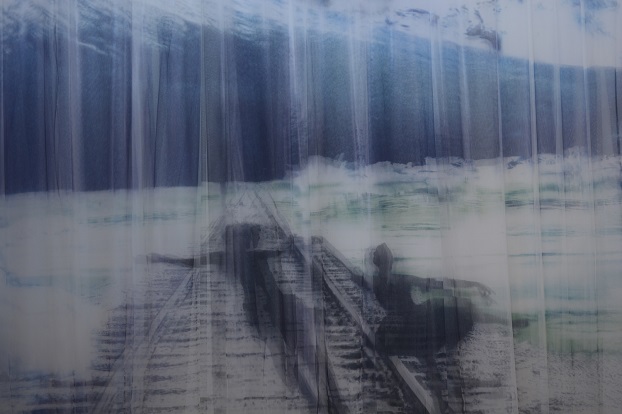
Jesus and a ballerina dance en pointe on railroad tracks that stretch toward the horizon. A man in a white suit covers his head in a prayer shawl. A photographer, using a camera fifty years out of date, snaps his photograph. A fishing trawler burns on the water. A young woman sits with her back leaning against a statue’s pedestal, reading on a warm spring day. A flock of pigeons takes flight over a canal in Venice.
These images, by Israeli-born artist Izhar Patkin, painted onto hanging, pleated curtains of tulle that line large, constructed rooms, are part of a longtime conversation between him and the great Kashmiri-American poet Agha Shahid Ali.
For me, they’re also deeply personal.
I knew Shahid when he began his collaboration with Izhar, and watched the first tantalizing glimmers of these images emerge over a decade ago. Shahid died in the last month of 2001. He was far too young, only 52 years old, and was only beginning to gain the worldwide attention his work deserved.
One of Shahid’s final poems, “The Veiled Suite,” was written when he was so ill he could no longer [pullquote align=”right”]Standing inside this room is like standing inside a memory that is also a dream that is also an epitaph that is also an idea of the world made simultaneously beautiful and tragic.[/pullquote]write using a pen, so dictated to a friend. It was composed specifically for Izhar and became the inspiration for one of Izhar’s grandest works, the monumental room, “The Veil Suite.” Standing inside this room is like standing inside a memory that is also a dream that is also an epitaph that is also an idea of the world made simultaneously beautiful and tragic. It is here that Jesus and the ballerina dance, and here the man in the white suit stands being photographed, while in the distance, mountains rise that could as easily be the Himalayas or the Rockies or the Alps.
All five of the rooms that were inspired by Shahid’s poetry have finally received their American debut at a major mid-career retrospective of Izhar Patkin’s work, currently on view at MassMoCA, in North Adams, Massachusetts. Years in the making, the centrality of their place in Izhar’s ouevre is evident by the overarching title of the show, The Wandering Veil.
For me, walking through these rooms is like paying a visit to Shahid. His presence is evident for anyone who knew [pullquote]For me, walking through these rooms is like paying a visit to Shahid.[/pullquote]him. I first read his work when I was in my twenties, shortly after his book A Nostalgist’s Map of America appeared. I was living in Tucson, Arizona, at the time, where many of the poems were written and set. Later, I would learn that Shahid worked for a while for the Tucson City Government, where his job was to dream up new street names for the rapidly expanding city!
It should be hardly surprising, therefore, that he often chose the image of a road to forge dream connections between the India of his birth and the America that he came to call home. As Shahid writes:
When on Route 80 in Ohio
I came across an exit
to Calcuttathe tempatation to write a poem
led me past the exit
so I could writeIndia always exists
off the turnpikes
of America
Those subterranean connections between his two homes, in which landscape and people and history and myth merge and often collide, come again vividly to life in Izhar’s paintings. His conversation, carried out against the backdrop of Shahid’s poetry, is between his own two homes, Israel and America. When their collaboration began, the two artists decided they didn’t want to present a schmaltzy Muslim-Jewish lovefest. Indeed, they joked about pretending to hate each other, about insisting on having dueling opening night parties, etc.
This didn’t happen, but what did is an extraordinary conjoining of sensibilities. The tensions, Shahid’s grief for what had happened to Kashmir within independent India, and Izhar’s anger over Israel’s continued occupation of the West Bank, mix with a love of country and heritage, and their sense of chosen exile. Here there are many veils, and each seems to reveal as much as it hides.
Izhar Patkin: The Wandering Veil is on view at Mass MoCA through September 1, 2014.
Tonight the museum will host a special tribute to Agha Shahid Ali. Agha Iqbal Ali, the poet’s brother and University of Massachusetts professor, Nikhil Melnechuk, Co-Executive Director of the Bowery Arts + Science and Ranbir Singh Sidhu, author of Good Indian Girls, will all read from Shahid’s work, inside the environment of Izhar Patkin’s painting.
More information at Mass MoCA: www.massmoca.org.
Ranbir Singh Sidhu is the author of Good Indian Girls and the winner of a Pushcart Prize and a New York Foundation for the Arts Fellowship in fiction, among other awards. Learn more at www.ranbirsidhu.com.













1 thought on “Izhar Patkin’s ‘Veil Suite’ at MASS MoCa: A Nostalgist’s Map of Agha Shahid Ali”
Comments are closed.